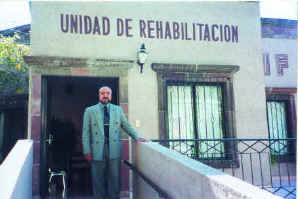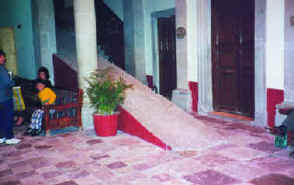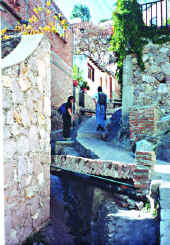




|

|
|
Dr. Carlos Perez Lopez, Director of DIF
(above) and Handicapped parking space across from the Unidad de
Rehabilitacion(below). |
|

|

 |
|
Walkways are not exactly accessible.
(left) The ramp at the hospital might warrant a stay after
attempting to get up it! |
|

|

|
Mexico: New Ideas in an Old Country
by Margi Ness
We had been driving for
two days. The trip from Boulder to
Guanajuato went by quickly. It had been 30 years since I’d driven to Mexico,
and I was pleased with the road improvements. To make time, we paid the price
and took the well-maintained toll roads. Zipping along, we arrived in Guanajuato,
a beautiful colonial city in the mountains northwest of Mexico City, long before
the required arrival time at the Instituto Falcon. The language school had
arranged for a family stay and we had to arrive in time to register for classes
and get to our family’s home for dinner.
Our elation at arriving in Guanajuato was short-lived. For
three hours we drove through the city’s maze of underground tunnels in search
of the school. Down we’d go into one tunnel and up we’d pop 10 minutes later
— in the same place we had started. We stopped and asked directions again and
again. People tried to be helpful, but between our poor Spanish and the
confusing streets, the sun was setting by the time we found the Instituto. Now,
we had to find a place to park on the narrow, cobblestone street. The closest
place was a block away. As we pulled into the rocky parking spot, we noticed a
"handicapped only" parking sign. What? In Mexico? I looked around to
see if there was a special reason for the sign. Directly across the street was a
building proclaiming Unidad de Rehabilitacion, a rehab center. I couldn’t
believe my good fortune. I was hoping staff at the school could help me find
people with disabilities or a place I could learn about services for the
disability community. Here, before getting out of the car, was just what I was
looking for. As we left to find another parking space, I resolved that I would
return the next day to see what this organization was all about.
My return led to an appointment with Dr. Carlos Perez Lopez, Director
de Asistencia a Personas con Discapacidad (director of assistance to persons
with disabilities). Dr. Perez Lopez explained how the program operates.
Assistance to Persons with Disabilities is part of DIF, a nationally funded
agency similar to the U.S. Department of Health and Human Services. DIF has
offices in every state and in many cities in the country. It provides a wide
array of services to poor people. State and local governments can supplement the
federal funds, so DIF services vary across the country based on the level of
additional support. The state of, and cities in, Guanajuato (Gte), one of the
wealthiest areas in Mexico, contribute significantly to DIF. Therefore, the
level of service in the area is higher than in most parts of the country. By
law, the president of the state DIF is the spouse of the Governor. In Guanajuato,
however, the Governor is the president because he is single. At the city level,
the spouse of the Mayor is DIF’s president.
Working with DIF is a statewide, non-governmental
organization called Union Guanajuantense de Personas con Discapacidad (union
of people with disabilities from Guanajuato). Twenty-four of the 48 cities in
Gte. have sub-associations that are members of the state union. The president of
the union is the Governor. The union advises the government regarding what
services are needed.
The main areas DIF and the union are currently focused on
are:
 |
Legislation |
 |
Accessible telecommunication |
 |
Sports, culture and recreation |
 |
Labor and work capacity |
 |
Education |
 |
Health |
 |
Transportation |
DIF coordinates services, but many organizations provide the
services. The Red Cross, for example, provides transportation, similar to many
areas of the United States. The only service DIF provides directly is
rehabilitation, the program directed by Dr. Perez Lopez.
There are three levels of rehabilitation clinics across the
state: Thirty-two cities have clinics with basic services; three have doctors
with some specialties; and one clinic has doctors in most specialties. It is the
goal of DIF to add ten additional clinics within one year so that every city in
the state will have a basic clinic. Fees are based on income. This is very
important because most people have no insurance.
The Gte. DIF has been very successful. In media
communication, for example, persons with disabilities are on the radio and
television talking about their lives and the problems they face. In education,
persons with disabilities are now mainstreamed. Not long ago, even cross-eyed
people were sent to a special school. In legislation, persons with disabilities
have the support of the state congress. Every two months, there is a meeting
with a congressional representative, a staff person from DIF, the president of
the union, and a volunteer lawyer. The lawyer helps write needed city and state
laws/regulations to help persons with disabilities. Dr. Perez Lopez believes the
Gte. DIF is the best in the country because of the direct connection between the
government, the union, and the service provider.
Despite their successes, Dr. Perez Lopez says the needs are
very great and the funding limited. The two major problems he is currently
focusing on are transportation and access to hearing aides. Although there is
some transportation available for persons with disabilities, there are no
accessible vehicles. I saw handicapped parking signs around the state, but once
at a location, maneuvering around could be difficult. Buildings are becoming
more accessible, but the narrow streets and sidewalks often cannot be widened to
allow a person in a wheelchair to navigate safely. The rolling topography in the
city of Gte. is a barrier to accessibility for that city. To get to our family’s
home and many other homes in the city, one had to climb up a long, narrow, steep
walkway. It would have been impossible in a wheelchair and difficult for people
with many other physical disabilities. In addition to the topography, the
designation of Gte’s Patrimonio Cultural de la Humanidad (an international
cultural heritage sight) makes it difficult to change architectural design
necessary to make buildings accessible.
Hearing aides are simply unaffordable. Many children need
hearing aides but at a cost of $800
per ear, they are out of reach. Dr. Perez Lopez has been writing grants to the
States and received 100 aides from ICARE International, a laboratory in
Minneapolis, but many more are needed. Ophthalmology used to be a major need
until Dr. Ward Mould, a New York doctor who retired in Guanajuato, procured used
equipment from the States and volunteered to set up and operate the
ophthalmology department. Dr. Mould recently died but his legacy continues. Dr.
Perez Lopez says Dr. Mould was a man with a big heart who he thinks about every
day.
Other U.S. agencies have been trying to help throughout
Mexico. Access Exchange International (AEI), a San Francisco-based non-profit
organization, reported a breakthrough in Latin America in the summer, 1999 issue
of Accessible Transportation Around the World." New commitments to
"mobility for all" were noted at a March Mexico City workshop led by
Tom Rickert, Executive Director of AEI. Sponsored by the Mexico City Metro, more
than 80 transportation officials and staff, as well as disability leaders,
participated. Projects are underway in Mexico City to make five key subway
stations accessible on two existing lines, along with nine stations on a new
line under construction. Access features will include elevators and ramps.
Guideways and signs for blind persons, with Braille and raised letters, have
already been installed at some stations. The planned access to portions of one
of the world’s largest subway systems is supplemented by current deployment of
25 lift-equipped buses and trolley buses on three major lines, with 65 more
vehicles scheduled to go into accessible service.
Mexico has made enormous strides in the last decade. Much remains. Businesses
such as ICARE and AEI are to be commended for assisting our neighbors to the
south. Working together, life for persons with disabilities across the globe is
improving.
top of page
|
|



